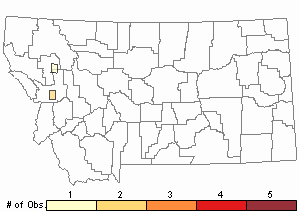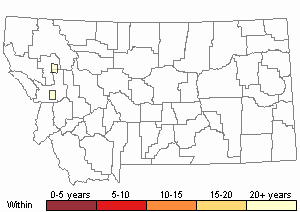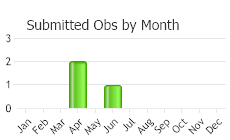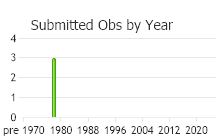View in other NatureServe Network Field Guides
NatureServe
Montana
Utah
Wyoming
Idaho
Wisconsin
British Columbia
South Carolina
Yukon
California
New York
Sub-rotund Ptychostomum Moss - Ptychostomum cyclophyllum
Other Names:
Bryum cyclophyllum
General Description
Plants: Acrocarpous (Vitt 1988). Soft (Crum & Anderson et al. 1981), growing in loose to crowded, large patches (FNA 2014) or clumps of erect shoots, sometimes growing with other mosses (Lawton 1971), green, occasionally with yellow tones. Stems mostly 5-30 mm in height, sometimes a little taller (FNA 2014), occasionally forked; rhizoids few to numerous (Lawton 1971); fertile branches with leaves dense at the top of the stem (comose) (FNA 2014).
Leaves: Laxly spaced on the stem, strongly twisted and curved to contracted when dry, spreading somewhat when moist, green above, sometimes with yellow tones, becoming brown over time, 0.5-3 mm in length, widely egg-shaped to round, flat or faintly cupped, scarcely larger near the top of the stem, the base all green (not red near the costa); margins flat, bordered, 2-layered in some places from base to mid-leaf; apex widely acute or broader, not apiculate; costa seldom within a few cells of reaching the apex (FNA 2014).
Leaf Cells: Border of 2-3 rows of long, slender cells (Crum & Anderson et al. 1981); lower laminal cells quadrangular and long, 3-5:1; medial and upper cells fine-walled, 2-3:1 (FNA 2014), oblong or somewhat diamond-shaped (Crum & Anderson et al. 1981); alar cells not swollen or pink (FNA 2014).
Phenology
Fruit ripens in summer (FNA 2014).
Diagnostic Characteristics
The leaves that are round to widely egg-shaped with a rounded apex, generally plane, and greatly contracted when dry are distinctive (FNA 2014).
Bryum weigelii resembles B. cyclophyllum, but has decurrencies that extend nearly to the next leaf below (FNA 2014).
Range Comments
North American Range
AK to NU, BC and AB, WA, CA, MT s to AZ and NM, MI, NY and NJ (FNA 2014). Known in Montana from Flathead, Lake, and Missoula Counties (Elliott 2016).
Observations in Montana Natural Heritage Program Database
Number of Observations: 3
(Click on the following maps and charts to see full sized version)
Map Help and Descriptions
Relative Density

Recency


 (Observations spanning multiple months or years are excluded from time charts)
(Observations spanning multiple months or years are excluded from time charts)
Habitat
Sandy soil or soil high in organic content in wet areas such as streambanks and wetlands (FNA 2014), rock fissures (Lawton 1971), tree roots exposed to occasional flooding (Crum & Anderson et al. 1981). Elevation: 0-9840 feet.
Reproductive Characteristics
Dioicous. Seta 20-50 mm, brown to red, thin, straight or a little bent. Capsule brown, sometimes with yellow tones, 2-4 mm in length (FNA 2014), drooping, with a neck not as long as the remaining part of the capsule (Lawton 1971); peristome fully formed; exostome dentitions yellow below, transparent above, without pores near the lower mid-line; endostome sections with egg-shaped openings; cilia long, transversely ridged (FNA 2014).
Specialized vegetative reproduction via gemmae in the leaf axils, the gemmae filamentous and forked, brown, with small papillae; seldom occurring (FNA 2014).
Stewardship Responsibility
References
- Literature Cited AboveLegend:
 View Online Publication
View Online Publication Crum, H.A. and L.E. Anderson. 1981. Mosses of Eastern North America. 2 volumes. Columbia University Press, New York. 1328 pp.
Crum, H.A. and L.E. Anderson. 1981. Mosses of Eastern North America. 2 volumes. Columbia University Press, New York. 1328 pp. Elliott, J.C. and A.K. Pipp. 2018. A Checklist of Montana Mosses (1880-2018). Updated 3 January, 2020. Montana Natural Heritage Program, Helena, Montana. 73 pp.
Elliott, J.C. and A.K. Pipp. 2018. A Checklist of Montana Mosses (1880-2018). Updated 3 January, 2020. Montana Natural Heritage Program, Helena, Montana. 73 pp. Flora of North America Editorial Committee, eds. 2014. Flora of North America North of Mexico. Volume 28. Bryophytes: Mosses, Part 2. Oxford University Press, Inc., NY. xxi + 702 pp.
Flora of North America Editorial Committee, eds. 2014. Flora of North America North of Mexico. Volume 28. Bryophytes: Mosses, Part 2. Oxford University Press, Inc., NY. xxi + 702 pp. Lawton, E. 1971. Moss Flora of the Pacific Northwest. Hattori Botanical Laboratory. Japan: Yamabuki-cho, Shinjuku-ku, Tokyo. 362 pages plus appendices.
Lawton, E. 1971. Moss Flora of the Pacific Northwest. Hattori Botanical Laboratory. Japan: Yamabuki-cho, Shinjuku-ku, Tokyo. 362 pages plus appendices. Vitt, D. J. Marsh, and R. Bovey. 1988. Mosses, Lichens & Ferns of Northwest North America. Seattle, WA: University of Washington Press. 296 p.
Vitt, D. J. Marsh, and R. Bovey. 1988. Mosses, Lichens & Ferns of Northwest North America. Seattle, WA: University of Washington Press. 296 p.
- Additional ReferencesLegend:
 View Online Publication
View Online Publication
Do you know of a citation we're missing? Elliot, J. C. 1993. Second checklist of Montana mosses. Unpublished report. U.S. Forest Service, Region 1. Missoula, MT. 45 pp.
Elliot, J. C. 1993. Second checklist of Montana mosses. Unpublished report. U.S. Forest Service, Region 1. Missoula, MT. 45 pp. Lawton, E. 1971. Keys for the Identification of the Mosses on the Pacific Northwest. Reprinted from 'Moss Flora of the Pacific Northwest'. Published as Supplement No. 2 of the Journal of the Hattori Botanical Laboratory. Nichinan, Miyazaki, Japan. 66 pp.
Lawton, E. 1971. Keys for the Identification of the Mosses on the Pacific Northwest. Reprinted from 'Moss Flora of the Pacific Northwest'. Published as Supplement No. 2 of the Journal of the Hattori Botanical Laboratory. Nichinan, Miyazaki, Japan. 66 pp. Smith, A.J.E. 1980. The Moss Flora of Britain and Ireland. Cambridge University Press, Cambridge. 705 pp.
Smith, A.J.E. 1980. The Moss Flora of Britain and Ireland. Cambridge University Press, Cambridge. 705 pp.
- Web Search Engines for Articles on "Sub-rotund Ptychostomum Moss"





